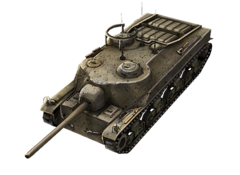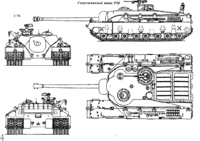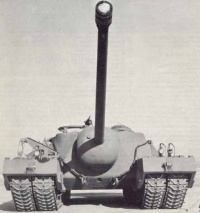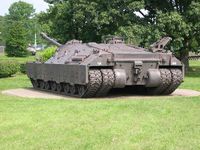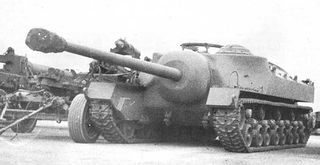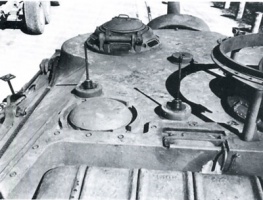T28
- This article is about the American TD. For the Soviet medium tank, see T-28.
T28 (Stock)
| 2580000 Cost |
| 1150 HPDurability |
| 59.21 / 62.45 Weight |
- Commander
- Radio Operator
- Gunner
- Driver
- Loader
| 254/50.8/50.8Hull Armor(front/sides/rear, mm) |
| 18/0/0Turret Armor(front/sides/rear, mm) |
| 440 h.p.Engine Power |
| 18 km/hTop Speed / Reverse Speed |
| 18 deg/sTraverse Speed |
| 225 damage |
| 170 mmAverage Penetration |
| 5.7 Time for Complete Loading |
| 26 deg/sGun Traverse Speed |
| 240 mView Range |
| 500 mSignal Range |
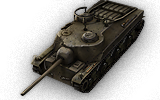
When you first play the T28, you will notice that it is much slower then the T25 AT. This tank is a bit faster than the T95, but not by much, so both tanks are easy prey for fast tanks. The frontal armor is very good for its tier, although the lower part of the armor is weaker. The 120mm AT gun can bring down even the strongest opponents with its rapid fire and good damage and accuracy. The only things the driver needs to worry about are its side and rear armor, as they are quite thin, allowing quick movers to take you down with ease. Be patient, stay in cover, and provide support for your allies and the T28 will prepare you greatly for the monster T95.

Gun
| Level | Gun | Average Penetration (mm) | Rate of Fire | Dispersion at 100 m | Aiming Time | Experience | Weight (t) | |
|---|---|---|---|---|---|---|---|---|
| VIII | 90 mm AT Gun T15E2 | 170/258/45 | 225/225/270 | 10.53 | 0.35 | 1.7 | 0 | 2050 |
| VIII | 105 mm AT Gun T5E1 | 198/245/53 | 310/310/400 | 8.08 | 0.38 | 1.7 | 18100 | 2400 |
| X | 120 mm AT Gun T53 | 248/297/60 | 400/400/515 | 6.59 | 0.38 | 2.5 | 51000 | 2790 |

Engine
| Level | Engine | Engine Power (h.p.) | Chance of Fire on Impact | Experience | Weight (t) |
|---|---|---|---|---|---|
| VI | Ford GAF | 440 | 20 | 0 | 569 |
| VI | Ford GAFM2A1 | 510 | 20 | 6560 | 569 |

| Level | Suspension | Load Limit | Traverse Speed (deg/s) | Experience | Weight (t) |
|---|---|---|---|---|---|
| VII | T28VVSS T46 | 62.45 | 18 | 0 | 12000 |
| VIII | T28VVSS T56 | 62.45 | 20 | 14600 | 12000 |

Radio
| Level | Radio | Signal Range (m) | Experience | Weight (t) |
|---|---|---|---|---|
| VI | SCR_508_US | 500 | 0 | 100 |
Compatible Equipment
Compatible Consumables
Player Opinion
Pros and Cons
Pros:
- Good damage, penetration, with the best DPM of all the tier 8 TDs
- Strong frontal armor
- Can be a surprisingly decent brawler with the correct crew, skills, and situation when fully upgraded and as top tier.
- Despite the easily penetrated lower hull plate, proper angling can cause even 200mm+ penetrating guns to bounce off. especial
Cons:
- Slow moving and traversing speed, making it vulnerable to mediums and lights
- Gun accuracy, dispersion and aim time are below average
- Weak side and rear armor
- Cupola weak spots
- Lower hull plate is penetrated easily with 200mm+ penetrating guns. (Ex. T34's 120 mm Gun T53A1 or the ISU-152's BL-1
Performance
Use this tank in the second line. The 254mm of frontal armour listed seems excellent, but unfortunately, that armour is only found in one place - behind the gun mantlet. In reality, it is:
- Side edges of upper hull: 203mm at 45 degrees
- Area next to mantlet: 203mm vertical
- Upper Glacis: 203mm at 70 degrees
As such, this tank, unlike the T95 with its extreme frontal armour, cannot really lead a spearhead unless it is top tier. Instead, it should function as a support sniper at mid range, where its small silhouette, large gun mantlet and good accuracy can be an advantage, and the 203mm of armour can start bouncing too. It'a a extremely satisfying feeling when a 122mm shell from the IS-3 pings off your armour.
Compared to the T28 Prototype, this tank doesn't have a turret and little gun depression, but each of its guns have a ~9% increase in rate of fire, a 0.01m accuracy buff and a 0.2 second faster aim time on the top gun. Thus while the Prototype makes a good sniper, this tank is more suited to going closer to the front lines, where it can quickly deploy its firepower to the team's advantage.
When at top tier, a fully upgraded T28 can become an surprisingly effective street-brawler. This playstyle can mainly be achieved deep in urban areas where buildings can provide cover from flanking LTs and MTs. Try to keep your sides and rear as little exposed to the enemy as possible constantly remain on the move, only stop when attempting mid-range shots and make sure you have team mates close by who can cover you if an enemy manages to slip into your side.
One thing most players seem to ignore (intentionally or unintentially) is that the T28 is VERY slow and weak against fast tanks. This tank needs other tanks to watch its back while the T28 moves foward slowly. Too many time I play this tank and my teammates ran off, even when there's a medium of light tank harassing me.
One thing that the T28 does surprisingly well is watching the flanks while your team is advancing, especially if all of your team's tanks went to one side of the map. Because the T28 is so slow, it's often the last tank in the group. With some map awareness and spotting from teammates, the T28 can be a serious road block for a flanker.
All in all, the T28 is a capable tank that can do tons of damage and block a few shots when you need it to. The only thing that stops it from using its full potential is teammates that don't support the T28, leaving it easy pickings for fast tanks. Having a platoon mate with you watching your back can be really helpful, and make this tank much more enjoyable.
Early Research
You will already have the 105mm from the T25 AT. Then you should research the engine and the tracks. Research the top 120mm last.
Historical Info
The rejected M6A2E1 project proposed that a limited number of assault vehicles be improvised by modifying the stock of T1E1 heavy tanks. However, a far more extensive program to develop a heavily armed and armored combat vehicle had been initiated in September 1943. Studies by the Ordnance Department indicated that such a vehicle would be required after the invasion of Europe to penetrate heavily fortified areas such as the German West Wall. The original concept proposed mounting the new 105mm gun T5E1 in a tank with the equivalent of 8 inch frontal armor using the electric drive system developed for the heavy tank T1E1 and the medium tank T23. The high velocity T5E1 gun had excellent penetration performance against concrete and when installed in a heavily armored chassis was expected to be extremely effective in reducing heavy fortifications. The Chief of Ordnance proposed that 25 of the new tanks be produced and estimated that they could be completed in eight to twelve months, approximately the same time that would be required to build a single pilot. Such a schedule was expected to make them available in time for operations in Europe. The Army Ground Forces did not agree and recommended that only three pilot models be constructed and that the electric drive be replaced by a mechanical transmission. After a conference with the various parties concerned, the Army Service Forces in March 1944 authorized the procurement of five vehicles, designating them as the heavy tank T28. The original specification was modified to increase the frontal armor to 12 inches raising the estimated combat weight to 95 tons.
Technical specifications
The proposed tank was a low silhouette vehicle without a turret. The 105mm gun T5E1 was to be mounted in the front of the hull with a traverse of 10 degrees to the right and left of center and an elevation range of -5 to +20 degrees.
The power package in the T28 (T95) was essentially the same as in the M26 Pershing tank, although the weight of the new vehicle was more than twice that of the latter. To handle the T28 (T95), the 500 horsepower Ford GAF engine and the torqmatic transmission required a final drive gear ratio that reduced the maximum vehicle speed to about eight miles per hour. In fact, the maximum recommended sustained speed was seven miles per hour at 2600 rpm. Due to its extreme weight and low engine power, the T28 (T95) had extremely limited obstacle-crossing ability and could not cross any of the portable bridges available at the time. The great weight of the vehicle also required considerable ingenuity in design to reduce the ground pressure to an acceptable level. This objective was achieved by the use of two sets of tracks on each side. The outer set, along with the four inch thick armor side skirts, could be removed and towed behind the vehicle when operating on a hard surface. Removing the outer tracks also reduced the overall width from 179 1/2 inches to 124 inches permitting rail transportation. At Aberdeen, an inexperienced four man crew removed the outer tracks under field conditions in four hours on their first try. An equal amount of time was required to reassemble them onto the vehicle. By the third try, the same team had reduced the time to remove or replace the outer tracks to 2 1/2 hours.
Crew
A crew of four was carried with the driver and gunner in the front hull on the left and right of the cannon respectively. The loader was at the left rear of the fighting compartment and the commander at the right rear behind the gunner. The driver and the commander were each provided with a vision cupola. A ring mount for a .50 caliber machine gun was installed around the commanders cupola. It could be used only with the commander standing in the open hatch and was the only secondary armament on the vehicle, except for the individual crew weapons. The gunner was equipped with a telescope alongside the cannon and a periscopic sight in the hull roof.
History
On 7 February 1945, a memorandum from the Chief of Ordnance requested that the T28 be redesignated as the 105mm gun motor carriage T95 because the cannon was not turret mounted and because of its limited secondary armament. OCM 26898, dated 8 March 1945, approved the name change and recorded the characteristics of the new vehicle. Because of the pressure of the wartime production program as well as the size and weight of the proposed vehicle, there was some difficulty in finding a facility to manufacture the five pilots. However, the Pacific Car and Foundry Company agreed to take on the project and in May 1945, (they were supplied with the basic vehicle design as well as detailed information on the gun mount and the horizontal volute spring suspension. Final design work began immediately. The first front end casting was delivered on 20 June and welding was completed on the first hull in August 1945.
Historical Gallery
Sources and External Links
| Light Tanks | IT1 Cunningham • IIT1E6 • IIT2 Light Tank • IIT7 Combat Car • IIIM22 Locust |
| Medium Tanks | IIT2 Medium Tank • IIIM2 Medium Tank • IVM3 Lee • VM4A2E4 Sherman • VM4 Sherman • VRam II • VIM4A3E8 Fury • VIM4A3E8 Sherman • VIM4A3E2 Sherman Jumbo • VIIT20 • VIIIM26 Pershing • VIIIT26E4 SuperPershing • IXM46 Patton • XM48A1 Patton |
| Heavy Tanks | VT14 • VT1 Heavy Tank • VIM6 • VIIT29 • VIIIT32 • VIIIT34 • VIIIT34 Independence • IXM103 • XT110E5 |
| Tank Destroyers | IIT18 • IIIT82 • IVM8A1 • IVT40 • VM10 Wolverine • VT49 • VIM18 Hellcat • VIM36 Jackson • VIIT25/2 • VIIT25 AT • VIIIT28 • VIIIT28 Prototype • IXT30 • IXT95 • XT110E3 • XT110E4 |
| USA | IIT18 • IIIT82 • IVM8A1 • IVT40 • VM10 Wolverine • VT49 • VIM18 Hellcat • VIM36 Jackson • VIIT25/2 • VIIT25 AT • VIIIT28 • VIIIT28 Prototype • IXT30 • IXT95 • XT110E3 • XT110E4 |
| UK | IIUniversal Carrier 2-pdr • IIIValentine AT • IVAlecto • VAngry Connor • VAT 2 • VIChurchill Gun Carrier • VIAT 8 • VIIAT 15A • VIIAT 7 • VIIIAT 15 • IXTortoise • XFV215b (183) |
| Germany | IIPanzerjäger I • IIIMarder II • IVHetzer • VStuG III Ausf. G • VIDicker Max • VIJagdpanzer IV • VIIE 25 • VIIE 25 "#1" • VIIJagdpanther • VIIIFerdinand • VIIIJagdpanther II • VIII8,8 cm Pak 43 Jagdtiger • VIIISnowstorm Jagdtiger 8.8 • IXJagdtiger • XJagdpanzer E 100 |
| USSR | IIAT-1 • IIISU-76 • IVSU-85B • VSU-85 • VSU-85I • VISU-100 • VISU-100Y • VIISU-152 • VIISU-100M1 • VIISU-122-44 • VIIIISU-152 • VIIISU-101 • IXObject 704 • IXSU-122-54 • XObject 263 • XObject 268 |
| France | |
| China | |
| Japan | |
| Czechoslovakia | |
| Sweden |
